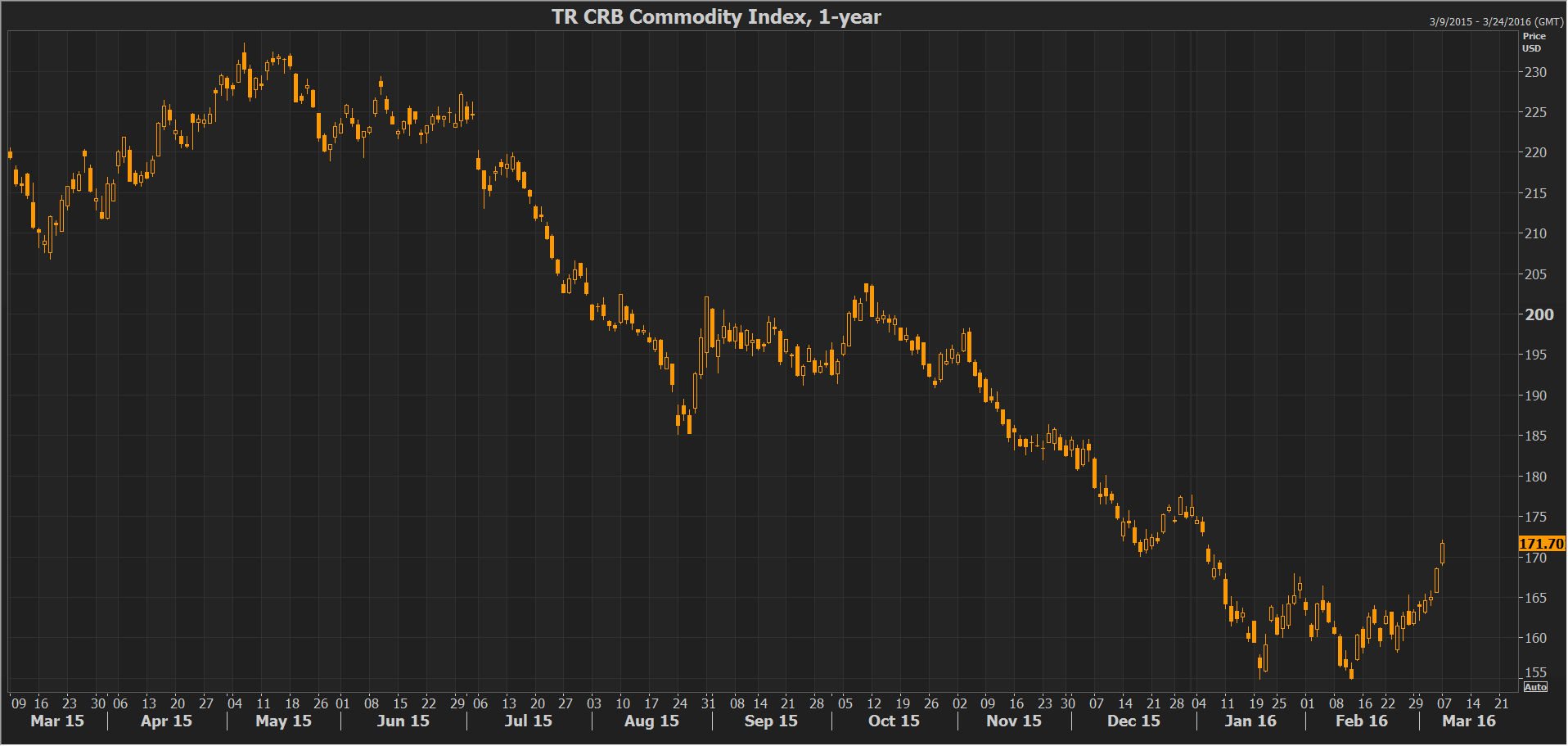Together with oil, gold is the other key commodity which market participants keep an eye on. Gold has climbed by more than $200 since the end of last year to around $1270 an ounce. The advent of ultra-loose monetary policies in the form of negative interest rates has benefited gold as has some of the uncertainty about the global economy and financial system vulnerabilities.
Another key commodity that has seen an impressive rally was iron ore as it has risen from around $38 a ton in mid-December to around $64 in latest trading in China.
The stabilization of commodities and the rally in oil prices from their lows in particular, has led to improved risk sentiment as markets saw excessive weakness in the oil price as something worrying in the global economy rather than a benefit to oil-consuming developed economies.
Although the commodity rally from the lows has been an impressive one, it should also be put in perspective. At 170, the index is quite far away from its 2011 peak of around 370 and even further away from its pre-crisis 2008 high of 473. A bounce off lows is an expected event and unless prices gain even more traction, it is difficult to say that the market has turned. Furthermore, it is not clear whether the conditions exist for a sustainable commodity upcycle. For example, global economic growth is expected to slow down during the year, with China, the world’s largest consumer of commodities, slowing down further and switching the focus of its economy away from commodity-hungry manufacturing and construction towards services. True commodities are probably quite cheap given all the beating they have taken for the past 5 years, but it remains to be seen if they can sustain certain levels and not fall to new lows.
Currencies that dance to the commodity tune: Australian and Canadian dollar
It has therefore also been an exciting time for traders that are preoccupied with the loonie and the aussie; two major currencies that are sensitive to commodities. Starting with the Australian dollar, the latest update is that the aussie made an 8-month high versus the US dollar, as it successfully managed to scale the 74 cents level; a level which caused problems for the aussie back in October and November of 2015. The aussie has been greatly helped by the rally in iron ore prices, which is a key Australian export. Positive risk sentiment, the expectation that the RBA will keep interest rates unchanged for the time being and better-than-expected economic growth and employment, have also been helping. The aussie as always remains vulnerable to negative news out of China, as was the case earlier today when disappointing Chinese trade statistics were published and there was some serious profit-taking in the aussie. The fact that the RBA Deputy Governor also sounded a note of caution with respect to the currency’s strength did not help either.
Turning attention to the Canadian dollar, the loonie made a three-month high versus the US dollar as the rebounding oil price boosted the fortunes of the currency. The loonie pushed the dollar below 1.33 from a high above 1.46. Interestingly, traders are reluctant to push the rate even lower during the last 2-3 sessions when oil made fresh highs, as if waiting for confirmation that the price of oil, which reached its highest since the beginning of January, is going to keep these gains. Both currencies are expected to remain volatile and attract a lot of trader attention in view of the sharp moves witnessed in commodity markets.

Forex trading and trading in other leveraged products involves a significant level of risk and is not suitable for all investors.
Recommended Content
Editors’ Picks
EUR/USD edges lower toward 1.0700 post-US PCE

EUR/USD stays under modest bearish pressure but manages to hold above 1.0700 in the American session on Friday. The US Dollar (USD) gathers strength against its rivals after the stronger-than-forecast PCE inflation data, not allowing the pair to gain traction.
GBP/USD retreats to 1.2500 on renewed USD strength

GBP/USD lost its traction and turned negative on the day near 1.2500. Following the stronger-than-expected PCE inflation readings from the US, the USD stays resilient and makes it difficult for the pair to gather recovery momentum.
Gold struggles to hold above $2,350 following US inflation

Gold turned south and declined toward $2,340, erasing a large portion of its daily gains, as the USD benefited from PCE inflation data. The benchmark 10-year US yield, however, stays in negative territory and helps XAU/USD limit its losses.
Bitcoin Weekly Forecast: BTC’s next breakout could propel it to $80,000 Premium

Bitcoin’s recent price consolidation could be nearing its end as technical indicators and on-chain metrics suggest a potential upward breakout. However, this move would not be straightforward and could punish impatient investors.
Week ahead – Hawkish risk as Fed and NFP on tap, Eurozone data eyed too

Fed meets on Wednesday as US inflation stays elevated. Will Friday’s jobs report bring relief or more angst for the markets? Eurozone flash GDP and CPI numbers in focus for the Euro.